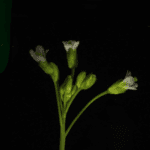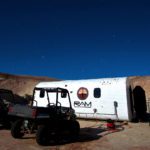Wild leek (Allium tricoccum; ramps or wild garlic) is a small forest herb very popular for the taste of its bulb and leaves. It usually grows along the ground of hardwood deciduous forests from the southern Appalachians in Georgia up to south-eastern Canada. In the last decades, intensive harvesting has decreased the abundance of natural populations of wild leek, leading some American states and Canadian provinces to confer to wild leek the status of vulnerable or endangered species, thus limiting or forbidding its exploitation. In the province of Québec, where our experiments were conducted, harvest is limited to 50 plants (or 200 g of any part) per person per year, and any kind of commerce is forbidden. Yet, illegal harvesting remains common and natural populations are still in decline. A better understanding of the optimal growth conditions for wild leek, combined with a characterization of the optimal planting density and harvest rates, could allow for sustainable exploitation of this resource through forest farming.
Looking overhead to improve growth on the ground
Wild leek is a spring ephemeral plant: it takes advantage of the high light availability prevailing in spring after the snow has melted and before the tree leaves overhead in the canopy unfold, blocking sunlight to the forest floor. Each spring, wild leek rapidly unfolds its own leaves and accumulates carbon reserves in the bulb. In late spring, soon after the forest canopy unfolds (known as canopy closure) the leaves of wild leek rapidly senesce (i.e., turn yellow then die). In our recent article published in Botany, we studied the impact of tree canopy composition and tree leaf phenology on the growth and leaf phenology of wild leek. Plant phenology is the study of timing of different life stages throughout the season (i.e., leaf unfolding, leaf senescence, flowering, seed production). We hypothesized that when growing under trees that unfold their leaves later in spring, such as oak, ash, walnut, or basswood, wild leek would delay its own leaf senescence and profit from the prolonged light availability, thus growing larger.

Fertilized wild leek flowers (left) and full-grown seeds (right). During summer after leaf senescence, flowers grow at the top of a floral scape that initiates from the bulb.
Our results can contribute to the conservation of wild leek by helping resource managers decide which sites are best suited for forest farming production or for transplantation when reallocating populations present in habitats that will be destroyed. At this point, we cannot recommend one particular tree species that is optimal for wild leek growth. However, we confirmed that late bud-bursting trees such as oak, ash, walnut, or basswood provide a good light environment for wild leek because of their late canopy closure. Gaps in the forest canopy, which can be due to the death of a tree for example, could also provide good light conditions but the amount of light reaching wild leek plots will depend on their position under the gap.We set up 30 plots under various types of trees in natural forests, maple forests exploited for sugar maple sap, and hardwood tree plantations. In each plot, we transplanted 90 wild leek bulbs. For two years, we monitored light availability throughout the spring, tree phenology, and wild leek growth and leaf phenology. As predicted, senescence of wild leek leaves happened later under late bud-bursting tree species, which led to enhanced growth: larger bulbs that divided more frequently and produced flowers with more seeds. The amount of light available after canopy closure in late spring, a measure representative of the canopy density, had limited effects on wild leek; the total light available throughout the wild leek growing season from early to late spring (integrating both canopy phenology and density) had the strongest positive effect on wild leek growth.

Light availability was assessed by taking four hemispherical photographs in each plot during spring: before, during, and after tree leaf unfolding.
Strategies for sustainable harvest of wild leek
Wild leek populations are very sensitive to harvesting. Available recommendations on sustainable bulb harvest rates range from 10% per 10 years to 8% or 10% of the wild leek stand annually. These recommendations, however, do not consider pre-harvest density of the plants. Indeed, wild leek stands can reach densities as high as 350 bulbs per m2, which could significantly limit its growth. In another study using plots ranging from 44 to 356 bulbs per m2, we observed that a lower planting density improved annual individual bulb growth, whereas plots at higher densities produced a higher bulb mass per area annually. In this experimental setup, a density of 90 bulbs per m2 was the best compromise between individual bulb growth and total yield per area. Given the very high variability of densities observed in natural populations, it appears advisable to recommend harvesters to maintain a given post-harvest density instead of harvesting a given percentage of the stand. In addition, to maximize post-harvest regeneration, government authorities should set a minimum density at which to keep natural wild leek stands.

As wild leek reproduction occurs principally through bulb division, natural stands can reach densities as high as 350 bulbs per m2.
Through the research we have been conducting over the last five years, we now have a better understanding of the effects of 1) the light environment provided by the tree canopy, 2) the planting density, and 3) bulb and leaf harvesting on wild leek growth and reproduction. With this knowledge, and data we and other research teams have acquired on the benefits of mineral fertilization and adjusting soil pH and the effects of light on seedling and older plant growth, forest farming and sustainable exploitation of wild leek are now within reach.Although less popular than bulbs, wild leek leaves are also edible and are commonly used in various recipes such as salads and pesto. Leaf harvest is a more sustainable exploitation of wild leek since the bulb does not die following a one-time defoliation. However, leaves are a major nutrient investment for the plant and a large part of the nutrients invested in them is taken back in the bulb during leaf senescence; harvesting the leaves thus deprives the plant from important nutrient reserves in addition to reducing the length of time that the leaves provide carbon energy reserves to the bulb through photosynthesis. Ultimately, harvesting leaves earlier in spring could hinder future growth. In the previously mentioned study we also demonstrated that harvesting only one leaf out of two and delaying the harvest to just before the onset of leaf senescence both significantly reduced the negative impact of the harvest on growth. Long-term studies are, however, still required to determine more precisely the sustainable leaf harvest rate.




